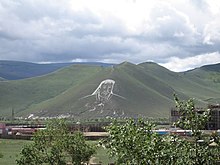Temujin (1162–1227) defeated and subjugated the "Three Mergids" in 1189 with the support of Tooril Khan of Kereit, the blood brother of his father. Another ally who helped Temujin in this venture was his own blood brother Jamukha of Jadaran clan. The Mergids had attacked the home of Temujin and captured his wife Börte of Hongirad tribe revenging for a much earlier event in which Temujin's father Yesukhei deprived a Mergid chief Chiledu his bride Hoelun of Olkhunut tribe, who became the mother of Temujin. The striving of Temujin to free his wife became a reason for the campaign against the Mergids. After the defeat of the Mergid, the reputation of Temujin rose rapidly and the leading members of the Khamag Mongol aristocracy enthroned him with title Chinggis Khan (Genghis Khan), as the ruler of Khamag Mongol. It is speculated to be an ancient form of the word "Tenggis"—ocean, sea.
A conflict of the Tatars with the Jin dynasty became a favorable opportunity for Temujin and Tooril Khan to defeat them in alliance with the Jurchens. At this point, Tooril Khan was granted the title Wang (王, Chinese for "king") by the Jin court and since then became known as Wang Khan. By the year 1201, the Taichuud and Jurkhin tribes were defeated and subjugated. Influential aristocrats of many other tribes and confederations were joining Temujin.
In 1201, a crisis ignited in the Keraite khanlig, in which the siblings of Tooril Wang Khan allied with Inancha Khan of Naiman and defeated Tooril. Wang Khan regained power in his kingdom with the support of Temujin. Temujin finally defeated and subjugated the Tatars in 1202. Nilha (childish) Sengum, son of Wang Khan, envied Temujin as his power was growing and persuaded his father to battle against Temujin. This venture led to a victory of Temujin and conquest of the Kereit Khanlyk. Wang Khan escaped alone into the southern deserts of the Naiman khanlig, where he was caught by the Naiman patrols, who killed him irritated as he claimed himself as Wang Khan.
Tayan khan of Naiman and his son Kuchlug initiated a campaign against Temujin in 1204. They allied with Jamukha, who competed with Temujin for the power over the Mongolic tribes. The Naiman troops outnumbered the Temujin's troops. At night at the eve of the battle, Temujin ordered each of his warrior to light ten bonfires, thus deceiving and demoralising Tayan khan, who was a weak warlord. Temujin won the battle. Tayan khan was captured but died of his wound, Kuchlug retreated to the river Irtysh where he was overtaken by Temujin and defeated. After this battle, Kuchlug escaped to Gur-Khan of Kara-Kitai.
As the Khanlyk of Naiman was conquered, Khasar, brother of Temujin, found a dignitary named Tata Tunga, who spread the Uigur alphabet among the Mongols. This alphabet became the basis of the Classical Mongol script.
By 1206, all the tribes and confederations of Mongolian steppe had come under the leadership of Temujin. The success of Temujin in consolidation of the Mongols was due to his flexibility, his cherishing of his friends and his elaborated tactics. A congress of the Mongol aristocrats on the river Onon in 1206 enthroned Temujin as Chingis Khaan (Genghis Khan) as Emperor of all Mongolia.

No comments:
Post a Comment